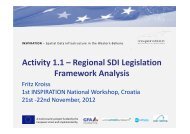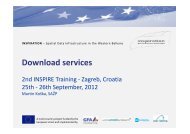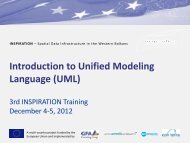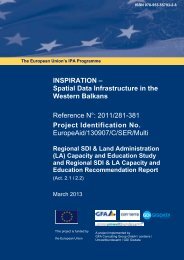MOVE - Moderation and Visualization for Group ... - INSPIRATION
MOVE - Moderation and Visualization for Group ... - INSPIRATION
MOVE - Moderation and Visualization for Group ... - INSPIRATION
Create successful ePaper yourself
Turn your PDF publications into a flip-book with our unique Google optimized e-Paper software.
Transparency ransparency in in decision decision making<br />
making<br />
background in<strong>for</strong>mation can be provided<br />
Participants can only gain confidence in a through h<strong>and</strong>outs during the course <strong>for</strong><br />
participatory way of thinking if their opinions evening reading. The largest share of the time<br />
are taken seriously in decision-making. This is should definitely be allocated <strong>for</strong> participatory<br />
why moderators should make transparent why work <strong>for</strong>ms like field work, exercises, group<br />
they proceed in a particular way, why<br />
work, role plays etc. (60%). Also, sufficient<br />
particular contents have been chosen etc. time should be reserved <strong>for</strong> discussions <strong>and</strong><br />
Participants should also be able to trace the conclusions about what has been experienced<br />
course of the seminar <strong>and</strong> follow discussion<br />
results.<br />
<strong>and</strong> learned (30%).<br />
Professional<br />
Professional Professional moderation moderation <strong>and</strong> <strong>and</strong> visualization<br />
visualization<br />
Needs-orientation<br />
Needs-orientation<br />
The degree of attention will be enhanced by<br />
Training courses make sense if they focus on using various ways of visualization. Keywords<br />
the trainees´needs. It is, there<strong>for</strong>e, important or key phrases are written on cards, legible<br />
to identify those needs at the beginning or <strong>and</strong> visible to everybody. This leads to<br />
even be<strong>for</strong>e a course. Ideally, this may imply precision, avoids monologues, <strong>and</strong> provides<br />
discussions with the beneficiaries that the an external memory. Additionally, flipcharts,<br />
trainees are in touch with, the trainees<br />
overhead projections, drawings <strong>and</strong> other<br />
themselves <strong>and</strong> their superiors.<br />
visuals are used. Trainers should be able to<br />
plan <strong>and</strong> conduct courses in a participatory<br />
Cooperation Cooperation <strong>and</strong> <strong>and</strong> participation<br />
participation<br />
way, encouraging participants to take over a<br />
Each idea counts, thus allowing <strong>for</strong> a fair central role. They should be able to provide<br />
dialogue without domination or hierarchies. brief input but, more importantly, guide<br />
Different experiences are equally important - group processes, lead discussions <strong>and</strong><br />
which is truly reflected in the way cards are<br />
treated as anonymous statements once they<br />
visualize discussion results.<br />
are pinned on the board. Individual, group Evaluation valuation<br />
<strong>and</strong> plenary work are driven by mutual<br />
The gradual elaboration of issues facilitates<br />
assistance which again taps <strong>and</strong> stimulates team work <strong>and</strong> a flexible approach to content<br />
the capacities <strong>and</strong> talents of all participants. <strong>and</strong> methodology. A critique <strong>and</strong> suggestion<br />
This allows <strong>for</strong> building on the participants’ board, a mood barometer, <strong>and</strong> a daily feedback<br />
strengths, <strong>and</strong> <strong>for</strong> reducing their weaknesses. committee ensure a shared responsibility<br />
Also, they feel they are being taken seriously,<br />
which increases their identification with<br />
training contents <strong>and</strong> results.<br />
among all participants.<br />
Learning Learning Learning by by self-reflection<br />
self-reflection<br />
Encouraging participants - whether in group<br />
work, exercises, role plays or video feedback -<br />
to reflect on their own behavior results in a<br />
greater impact on memory. These<br />
participatory training methods may also offer<br />
practical starting points <strong>for</strong> problem-solving<br />
in comparable situations.<br />
10/60/30 10/60/30 rule<br />
rule<br />
According to experiences gained in adult<br />
education, the following ‘rule of thumb’ <strong>for</strong><br />
different work <strong>for</strong>ms can be quite useful.<br />
Theoretical input should be limited to an<br />
absolute minimum (10%). Additional<br />
16
















